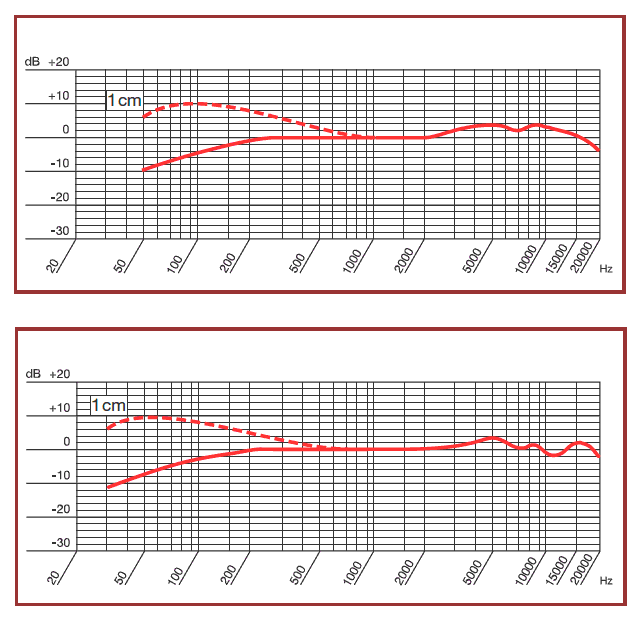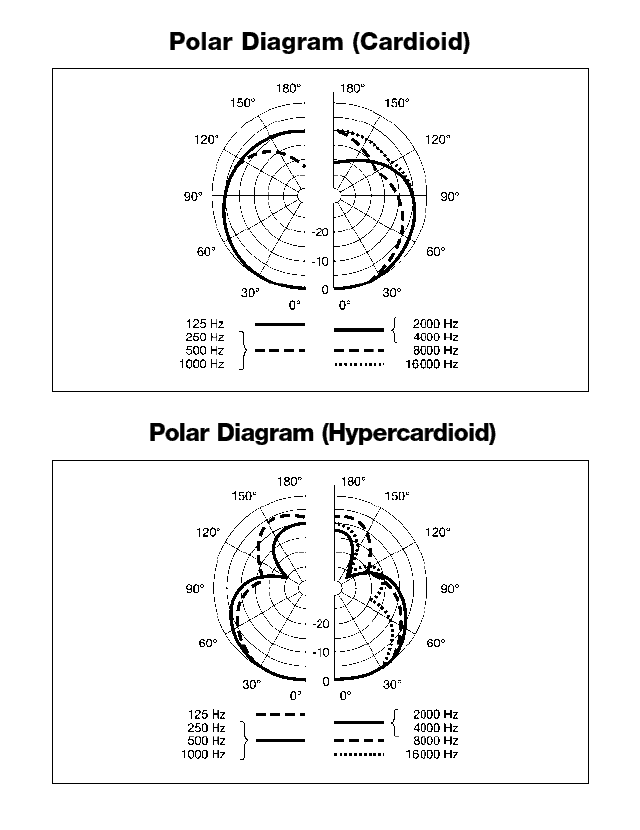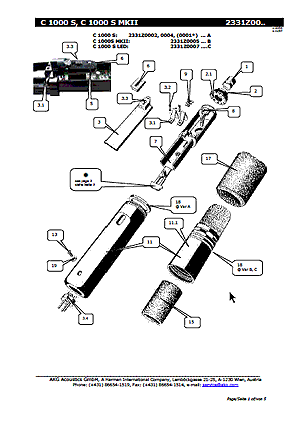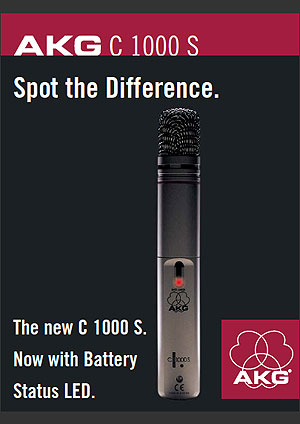
The AKG Model C1000S
cardioid condenser microphone
The C1000S combination of a high-quality backplate condenser transducer and capsule shock mount optimizes handling and cable noise rejection. The microphone body consists of a massive aluminum shaft and screw-on brass front tube with a rugged stainless steel mesh cap. The microphone uses a standardized three-pin male XLR output connector.
Cardioid frequency response (top), hypercardioid (bottom, with PPC1000).Slipping the PPC1000 Polar Pattern Converter on the capsule will change the microphone’s pickup pattern from cardioid to hypercardioid. This makes the microphone even less sensitive to sounds arriving from the sides and rear, resulting in higher gain before feedback when you use monitor speakers on stage.
Polar pattern Converter, Presence Boost Adapter.The supplied PB1000 Presence Boost Adapter boosts the sensitivity of the microphone by approximately 5 dB between 5 kHz and 9 kHz for optimum speech intelligibility.
Text, photographs and illustrations are via the courtesy of AKG.Description
The AKG Model C1000S gradient condenser microphone uses a low-noise pre-polarized back plate (electret) and is ideal for a variety of recording and sound reinforcement applications. Its polar pattern can be quickly converted from cardioid to hypercardioid by placing an acoustical converter over the end of the microphone capsule; this has virtually no effect on the on-axis response of the microphone. The on-axis response of the C1000S has a gentle (-6 db/octave) roll-off below 200 Hz which has been tailored for the normal close-in use of cardioid and hypercardioid microphones in studio recording and sound reinforcement applications. The microphone may thus be used in close-in application with no need for further equalization. The C1000S may be powered by a 9-volt battery or by phantom powering over a range from 9 to 52 VDC. The included PPC1000 Polar Pattern Converter allows quick changeover from cardioid to hypercardioid. A silent on/off switch is recessed to prevent inadvertent shut-off. The included Presence Boost Adapter piece PB1000 creates an emphasis of the higher frequencies from 5 to 9 kHz by about 3 to 5 dB, which not only improves the transmission of sibilance but may be advantageous when recording instruments requiring greater high-frequency content in their audio spectrum.C1000S
The C1000S is a small-diameter back-plate electret design with a total dynamic range of 118 dB. It normally has a cardioid pattern, but when the PPC1000 hypercardioid polar pattern converter is installed over the diaphragm assembly, the pattern becomes hypercardioid for extra reach. The extended frequency response has slight peaks at 5 kHz and 9 kHz, which will add presence for most applications. The response has further been tailored to have a gentle bass roll-off commencing at 150 Hz. For close use, this will be compensated for by normal proximity effect bass rise. The PB1000 presence booster may be installed while in the cardioid mode, providing an additional 5-dB brilliance peak between 5 to 9 kHz, making the C1000S appealing for use as a stage and studio drum overhead microphone, on string instruments, or wherever indicated. A battery on/off switch, slightly recessed, makes the microphone useful for a variety of hand-held and on-stage applications.Music and On-stage Applications
1. Percussion Pickup: The extended frequency response of the C1000S does great justice to cymbals, brushes on snare drums, and all kinds of metal-against-metal transients. The small-diameter diaphragm exhibits very little narrowing of the pickup pattern at high frequencies, so the microphone responds well to a number of instruments, which may be placed anywhere in its frontal pickup zone. With its moderate output level of 6 mV/Pa it can easily be padded at the console input when used with the highest-level drums.2. Horn/Woodwind Pickup: In multi-track recording, natural timbres are usually preferred by mixers and producers, reserving for post-production any specific EQ of the basic tracks. Therefore, a microphone that is basically flat and uncolored is preferred. Because of the extended high-frequency response of the C1000S, we recommend placing the microphone slightly off the axis of the bell of brass instruments. For woodwinds, the microphone position should be well off the axis of the bell, looking down on the instrument. (There is very little radiation from the bell of woodwind instruments except at the lowest frequencies.)
3. Guitar Pickup: The unamplified sound of an acoustic guitar is subtle and often quite soft. Place the C1000S in the region of the tone hole, on the body of the instrument, at a distance of about 18 to 20 inches. Proximity effect will round out the bottom end nicely, balancing the extended high end of the microphone. If the C1000S is employed for miking an acoustic guitar during a live performance, we recommend that the PPC1000 be considered if feedback or stage leakage is an issue.
4. String Pickup: Massed strings are often a problem in the 2500- to 3000-Hz range and can sound rather "screechy" if not properly picked up. Avoid at all costs placing any microphone perpendicular to the top plates of the instruments. When miking a violin section, place the C1000S overhead and slightly to the back of the section; this should put it well off the axes of the violin top plates. Use the C1000Ss in multiples, panning them for a rich stereo presentation.
5. Vocal Pickup: Most solo vocalists prefer a so-called vocal mike, one that complements their voice in one way or another. However, a vocal group, small or large, will benefit from the flat response of the C1000S, with its clean uncolored sibilants.
Speech Applications
In those applications where the microphone can afford to be seen, a C1000S, with its hypercardioid converter and positioned at about 45 degrees off-axis at a distance of about two feet from the talker, will produce about as natural a speech quality as you could desire.Specifications
- Frequency Range: 50 Hz to 20 kHz
- Pickup Patterns: cardioid; hypercardioid with PPC1000S polar adapter
- Sensitivity: 6 mV/Pa
- Impedance: 200 ohms
- Equivalent Noise Level: 19 dB(A)
- Maximum SPL for 0.5% THD: 137 dB
- Power Requirement: 9 to 52 VDC/9V
- Battery Size: 1.3" diameter x 8.7"
- Net/Shipping Weight: 9.7 oz/1.8 lbs
Battery or phantom power is required.The C1000S is a condenser microphone and therefore needs a power supply. An internal 9V battery enables you to use the microphone with no loss in audio quality even if no phantom power supply is available. When operating off phantom power, however, the microphone will automatically switch to phantom powering mode. The microphone provides a balanced output on a 3-pin male XLR connector.
Download the Service Manual for this mic.
Download the Marketing Brochure for this mic.






